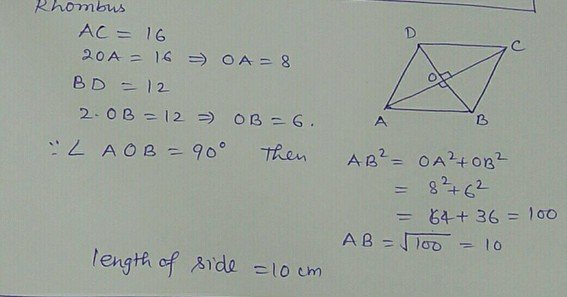In geometry, a rhombus is a type of quadrilateral characterized by four sides of equal length. A distinctive feature of a rhombus is that its diagonals bisect each other at right angles (90 degrees). Given the lengths of the diagonals, one can calculate the length of each side using these properties.
Understanding the Relationship Between Diagonals and Side Length
The diagonals of a rhombus intersect perpendicularly, dividing it into four congruent right-angled triangles. If we denote the diagonals as d1d_1 and d2d_2, each diagonal is split into two equal segments at the point of intersection. This creates right-angled triangles where the legs are d12\frac{d_1}{2} and d22\frac{d_2}{2}, and the hypotenuse is the side length aa of the rhombus.
Applying the Pythagorean theorem to one of these triangles:
a=(d12)2+(d22)2a = \sqrt{\left( \frac{d_1}{2} \right)^2 + \left( \frac{d_2}{2} \right)^2}
Example Calculation
Given the diagonals EG=16EG = 16 units and FH=12FH = 12 units:
-
Calculate half the lengths of the diagonals:
EG2=162=8 units\frac{EG}{2} = \frac{16}{2} = 8 \, \text{units}
FH2=122=6 units\frac{FH}{2} = \frac{12}{2} = 6 \, \text{units}
-
Apply the Pythagorean theorem:
a=82+62=64+36=100=10 unitsa = \sqrt{8^2 + 6^2} = \sqrt{64 + 36} = \sqrt{100} = 10 \, \text{units}
Therefore, the length of each side of the rhombus is 10 units.
Properties of a Rhombus
-
Equal Sides: All four sides are of equal length.
-
Diagonal Bisectors: Diagonals bisect each other at right angles.
-
Angle Bisectors: Diagonals bisect the interior angles of the rhombus.
-
Area Calculation: The area AA can be calculated using the formula:
-
A=12×d1×d2A = \frac{1}{2} \times d_1 \times d_2
FAQ
1. How do the diagonals of a rhombus relate to its side length?
The diagonals intersect at right angles and bisect each other, forming right-angled triangles with the sides of the rhombus as the hypotenuse. This relationship allows the use of the Pythagorean theorem to calculate the side length.
2. Can the side length of a rhombus be determined if only one diagonal is known?
No, both diagonals are required to calculate the side length using the method described.
3. Are the diagonals of a rhombus equal in length?
No, the diagonals of a rhombus are generally of different lengths but always bisect each other at right angles.
4. How does the area of a rhombus relate to its diagonals?
The area of a rhombus is half the product of its diagonals:
A=12×d1×d2A = \frac{1}{2} \times d_1 \times d_2
5. Is a square considered a rhombus?
Yes, a square is a special type of rhombus where all interior angles are right angles, and the diagonals are equal in length.
Understanding the geometric properties of a rhombus allows for the calculation of various dimensions when certain measurements, such as the lengths of the diagonals, are known. This knowledge is fundamental in geometry and has practical applications in fields requiring precise measurements and constructions.










